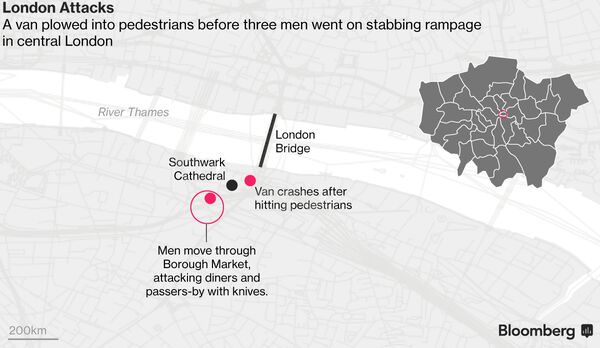
The attack, which killed seven people, was the second time in three months that London has come under attack after a similar assault on the country’s Parliament in March. Prime Minister Theresa May was accused on Sunday evening by Labour Party leader Jeremy Corbyn of failing to protect the public by starving the police of funds, Bloomberg reported.
And yet, the three terrorists who carried out the London Bridge attack were dead within eight minutes of the incident starting after police officers -- who are generally unarmed in the U.K. -- fired 50 rounds. Four years ago, it took 15 minutes for police to arrive on the scene when an off-duty soldier was attacked by two Islamic extremists. Even then, they shot to wound -- rather than kill -- the assailants.
“The fact that the response time to these attacks was really quite quick, and the authorities didn’t hesitate to shoot these individuals down, is a reflection of the fact that the police are on the front foot,” said Raffaello Pantucci, director of international security studies at the Royal United Services Institute in London.
“We have a fantastic capability in this country and we’ve always been able to develop it, change it in response to the threat,” Metropolitan Police Commissioner Cressida Dick said on Monday in a BBC Radio interview. “We will need to change again.”
It’s more than just the style of policing that’s evolved as the city adjusts to a new brand of do-it-yourself terrorism that involves tiny cells rather than sprawling support networks. The face of London has changed, too, as bollards, railings and subtler forms of protection have been placed near landmarks and on sidewalks. Authorities want to defend the city, which is proud of its historic stoicism and show-must-go-on attitude through decades of terrorism, without squeezing freedoms.
Security Landscape
“There’s a lot of conversation about the security landscape and how to make even benches a protective feature so that it doesn’t make everyone feel like they are living in a fortress,” said Brooke Rogers, reader in risk and terror at King’s College London. “I’ve seen the testing of some of these bollards and they actually drive very large trucks into them.”
Police are stepping up drills and security on the streets as the challenge facing them continues to shift. Terrorists are using cars and knives, as they did Saturday night and in the March attack outside Parliament, which are harder to pick up in advance than explosives.
Whereas in the past, “there was a much stronger sense of organization with a network component,” according to Florian Otto, head of Europe and Central Asia analysis at Verisk Maplecroft, it’s now “much more atomized” with jihadists radicalizing in isolation from organized groups.
‘Very Challenging’
“We seem to be facing a threat that is posed by people with largely a domestic focus, although there are some international dimensions,” said Dick. “We’re dealing with people who appear very volatile, very unstable, many of them, people who are prepared to use low-tech methods and sometimes go from thinking about the idea to actually carrying out an attack in a very short space of time. So this is very, very challenging.”
Security services catch far more would-be-attackers than they miss. The security and intelligence agencies “disrupted five credible plots” since the Westminster attack, May said on Sunday. Home Secretary Amber Rudd said last month that security forces are looking at 500 different plots and monitoring about 3,000 people on a “top list” of suspects. Another 20,000 people feature on a lower-level list of people who have been probed at some point but are deemed less of a threat.
“It really is safer than ever,” Rogers said. “In terms of the level of preparedness -- the plans that have been put in place, the strategies, the practicing that takes place so that organizations can work together -- all of the tools they have to respond mean we’re more prepared than ever.”
While police are fighting the renewed threat from Islamist terror, their budgets have been squeezed by austerity -- something that’s become an election issue with the opposition Labour Party accusing May of putting security at risk. On May’s watch as home secretary, the number of police officers in England and Wales declined by about 15 percent.
Home Office figures show London has lost some 1,750 officers since the Conservatives came to power in 2010. With four days to go until the general election, May is promising greater powers for police, while Corbyn is pledging an increase in numbers.
As the election campaign increasingly turned to focus on terror, Londoners were taking the attacks in their stride. Cafes, underground trains and restaurants were full on Sunday, even as London Bridge remained cordoned off. Following an absence of large-scale killings since 2005, when four suicide bombers attacked the transit system, London is once again getting used to terror.
“If something did happen here, who’s going to stop it?” asked Laura Winner, 33, a market- stall holder in Brick Lane, east London. “It’s just an open road. You’ve just got to get on with it. They want you to be scared.”
Patricia Green, 69, was carrying on as normal. She said she has worked in Brick Lane -- an area famous for being home to successive waves of immigrants over the centuries -- since 1953.
“Londoners are used to it,” she said. “For most of the people in London now, it’s just a way of life for them.”

